Table of Contents
MAPPING THE MOON
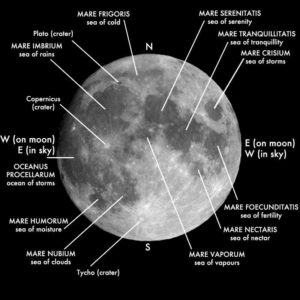 |
What’s where on the moon? The Full Moon Atlas is a complete collection of interactive lunar maps, variously charting craters, mountains, lakes, seas, and valleys. |
| Google Moon, developed with scientists from NASA’s Ames Research Center, includes a map of visible images (as in what you would see if you were in orbit around the moon), a lunar terrain map, a map of Apollo landing sites, and a collection of geological and topographic charts. | |
| A Survey of Moon Maps Since the 17th Century is a fascinating historical overview of selenography – that is, moon mapping – with wonderful historical and modern images. |
TEAM MOON: A GIANT LEAP FOR MANKIND
The moon has its own official holiday. Moon Day, July 20, commemorates the first landing of men on the moon in 1969.
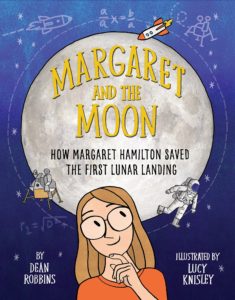 |
By Dean Robbins, Margaret on the Moon (Knopf, 2017) is the picture book story of Margaret Hamilton, who hand-wrote the code that allowed NASA to put a man on the moon. For ages 4-8. |
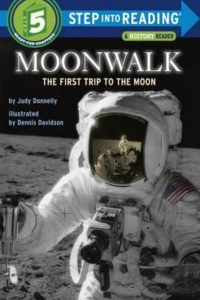
|
Judy Donnelly’s Moonwalk: The First Trip to the Moon (Random House Books for Young Readers, 1989) is a short chapter book illustrated with drawings and photographs, covering the Apollo 11 mission from blast-off to splash-down. Drama, human interest, and fascinating information for ages 6-9. |
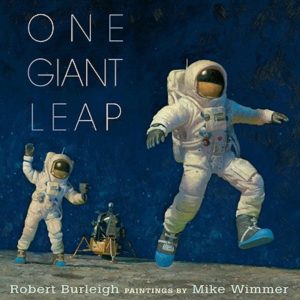 |
Robert Burleigh’s One Giant Leap (Puffin, 2014) is a lovely picture book account of the 1969 moon landing for ages 6-9. |
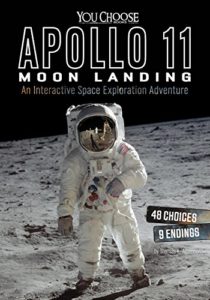 |
Can you put a person on the moon? By Thomas K. Adamson, You Choose: Apollo 11 Moon Landing (Capstone, 2016) is an interactive space exploration adventure in which you’re trying to beat the Russians to land a man on the moon. Make your choices and experience one of nine possible endings. For ages 8-12. |
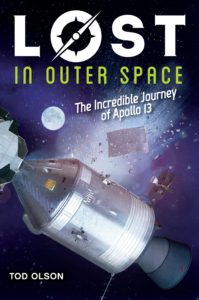 |
Tod Olson’s Lost in Outer Space: The Incredible Journey of Apollo 13 (Scholastic, 2017) is the gripping story of Apollo 13, the mission that never made it to the moon. One of the exciting Lost series – a good bet for adventure-loving kids ages 8-13. |
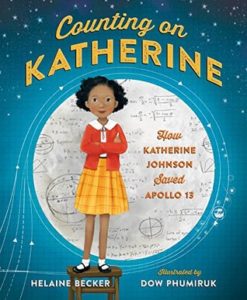 |
Helaine Becker’s Counting on Katherine (Henry Holt, 2018) is the story of African-American mathematician Katherine Johnson, whose calculations helped save the Apollo 13 mission. For ages 5-9. |
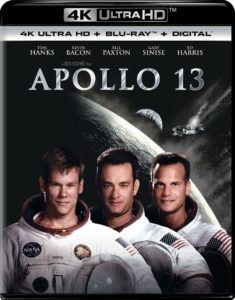
|
The 1995 movie Apollo 13, directed by Ron Howard and starring Tom Hanks as astronaut Jim Lovell, is the story of the struggle to return the crew of the 1970 Apollo 13 mission safely to Earth after their spacecraft was crippled by an oxygen tank explosion. Rated PG for language and emotional intensity. |
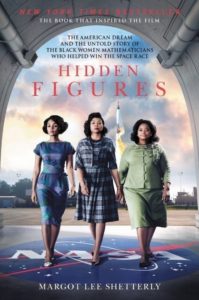 |
Margot Lee Shetterly’s Hidden Figures (William Morrow, 2016) is the story of the black female mathematicians whose calculations were crucial to NASA’s achievements in space. Also available are a Young Reader’s edition of the book for ages 8-12 and a picture book version for ages 4-8. |
| The excellent movie version of Hidden Figures (2016) is rated PG. | |
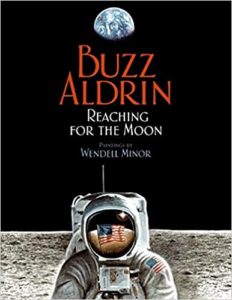
|
“We all have our own dreams. This is the story of how mine came true.” So begins Buzz Aldrin’s Reaching for the Moon (Perfection Learning, 2008), an appealing child-friendly autobiography, illustrated with dramatic paintings by Wendell Minor. The book covers Aldrin’s childhood, education at West Point, training in the space program, and, of course, the famous voyage in which he became the second man to set foot of the moon. An appendix has a chronology of space exploration. For ages 6-9. |
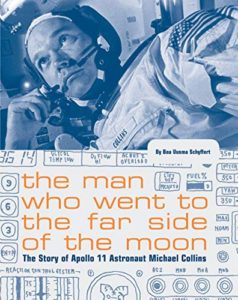 |
I’ve always had a soft spot for Michael Collins, the Apollo 11 astronaut who had to stay in the space capsule while Neil Armstrong and Buzz Aldrin took their giant steps for mankind. And his story is fascinating. Bea Uusma Schyffert’s biography of Collins, The Man Who Went to the Far Side of the Moon (Chronicle Books, 2003), is packed with unusual information and personal reminiscences, and the scrapbook-style design – including handwritten notes and snapshots Collins took in the periodic 48-minute episodes without radio communication during his fourteen orbits of the far side of the moon – makes for an addictive read. For ages 9-14. |
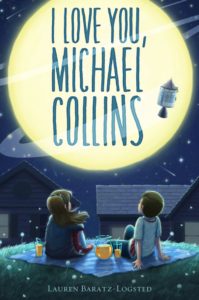 |
In Lauren Baratz-Logsted’s I Love You, Michael Collins (Square Fish, 2018), it’s 1969 in the months leading up to the Apollo 11 moon launch and Mamie’s class has been given an assignment to write letters to the astronauts. Only Mamie chooses to write to Michael Collins, the man who never walked on the moon but rather stayed with the ship. Mamie’s loneliness and isolation at home echo Collins’s isolation in space – but for both, the conclusion is that someone has to stay with the ship to bring everybody safely home. For ages 8-12. |
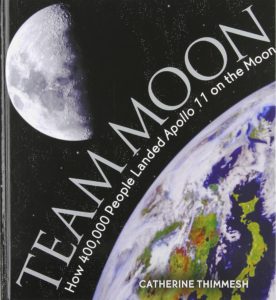
|
Catherine Thimmesh’s Team Moon (Houghton Mifflin Harcourt, 2015) – subtitled “How 400,000 People Landed Apollo 11 on the Moon” – is an enthralling 80-page picture-book history, illustrated with superb color photographs. Featured are the stories of the many people behind the famous mission: the seamstresses who made the space suits (twenty-two layers of five different kinds of fabric), the engineers who designed the Portable Life Support Systems, the biologists who worried about lethal lunar bacteria, and many many more. We now take the moon landing for granted – but this book reminds us how complex, difficult, and risky Apollo 11 really was. For ages 10 and up. |
| This Team Moon lesson plan has discussion questions, printable student worksheets, and a book club guide to the book. | |
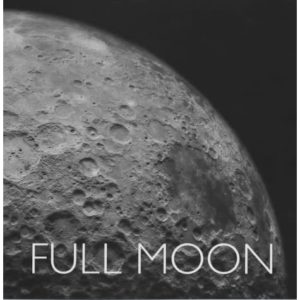
|
Michael Light’s Full Moon (Knopf, 1999), a marvel of science photography, is a compendium of NASA’s black-and-white and color photos from the Apollo missions, ordered so as to create a coherent story from blastoff to touchdown. All ages. |
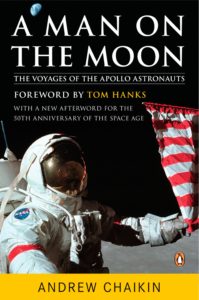
|
Andrew Chaikin’s A Man on the Moon (Penguin, 2007) is a superb history of the Apollo missions, based on extensive research and dozens of interviews, and crammed with compelling information and human interest. There’s a wonderful account of the astronauts learning geology – there’s a lot more to collecting moon rocks, it turns out, than simply grabbing the first rock you see. An addictive read for teenagers and adults. |
| From Smithsonian Education’s Idea Lab, Walking on the Moon uses primary sources (photos, audio and video clips) to explore the history of the Apollo 11 mission. | |
| From the PBS Design Squad Nation in collaboration with NASA, On the Moon is a downloadable activity guide of moon-mission-related engineering projects variously appropriate for grades 3-8. For example, kids design an air-powered rocket that can hit a distant target, build a rubber-band-powered car, construct a cardboard crane and test its load-lifting capacity, and make and operate a solar water heater. Included in the guide are complete instructions and student activity sheets. | |
| From NASA’s Lunar and Planetary Science, The Moon has a detailed moon fact sheet, lists of books about the moon, and information on all current and past lunar missions. | |
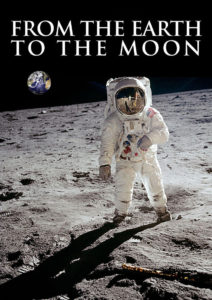 |
The HBO miniseries From the Earth to the Moon (1998, 2004, 2005), available on DVD, is a superb 12-episode account of NASA’s Apollo space program from 1961 to 1972. Well worth viewing. |
PLANTS, ANIMALS, YOU, AND THE MOON
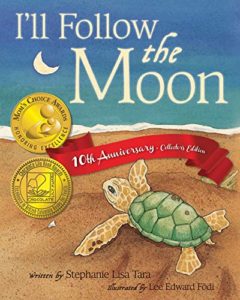 |
Stephanie Lisa Tara’s I’ll Follow the Moon (Brown Books, 2011) is a gentle poetic account of a baby green sea turtle’s nighttime journey from nest to ocean, following the light of the moon. For ages 3-7. |
| For more information on green sea turtles, see the National Geographic’s Green Sea Turtle. |
|
| Does the Moon Affect Plants? has overviews of planting by the moon, moonlight and biorhythms, and gravitational effects of the moon on plants, with references for further investigation. | |
| Does the moon affect YOU? Well…probably not. See Moon Myths for a discussion. | |
| Does the full moon make you crazy? From Scientific American Mind, Lunacy and the Full Moon discusses and debunks the lunar lunacy effect. | |
| Can the moon cause earthquakes? Check it out here. |
